The driver in the pickup truck swerved across the line and nearly missed a vehicle in the other lane. He was talking on a cellphone.
The driver of the sedan narrowly escaped ramming the rear end of the car in front of her. She didn’t realize the traffic light had turned red. Why? She was applying her makeup.
Both of those situations are considered distracted driving and both drivers, if caught, will face increased fines when new penalties go into effect on Feb. 1, 2020.
If common sense and awareness of the rules of the road have not been effective in curbing distracted driving, perhaps the potential for a major hit to the pocketbook will have the desired results. But it won’t happen quickly because some people feel the rules are for the other person.
Police personnel will be vigilant in their enforcement of the new levels of fines because by doing so, they are sending a clear message to drivers who use hand-held cellphones, text, read a book, apply makeup, discipline children in the backseat — you are a danger to yourselves and to others on the roads.
On Feb. 1, fines for a first distracted driving offence are to rise to $580 from $280. Add on four demerit points. A second offence in the same year will cost $1,400 plus four more demerits and a seven day vehicle seizure. If the message hasn’t gotten through and there is a third offence within the year, the fine will be $2,100, four demerit points and a seven day vehicle seizure.
There are reasons for what some say are harsh penalties. In 2018 distracted driving was blamed for more than 6,000 collisions in Saskatchewan, 774 injuries and 22 deaths. Since May of this year, police officials have given out 900 tickets a month for distracted driving.
The hit to the wallet is small change when considering the ultimate possibility for failing to follow the rules — serious injury or even death. No cellphone call or extra touch of mascara is worth such consequences.
Joyce Walter can be reached at [email protected]
The views and opinions expressed in this article are those of the author, and do not necessarily reflect the position of this publication.




